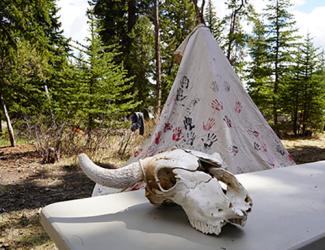Wind River Reservation students attend camp on the Bridger-Teton
Students learn about the outdoors from Tribal educators
May 31st, 2023

Tucked among the pines and sagebrush meadows, along the banks of the Buffalo Fork River, students from multiple Wind River Reservation schools traveled west of the continental divide to the Blackrock District administration site on the Bridger-Teton National Forest. The purpose of their visit was to take part in an educational and cultural experience known as the Blackrock Field Camp.
“This is land that is sacred to the local Tribes,” said Todd Stiles, Jackson District Ranger. “Providing the students an opportunity to learn about their culture and the outdoors on their ancestral lands is a huge benefit.”
The Blackrock Field Camp began in 2016 as an idea for children on the Wind River Reservation to experience the outdoors, in an area that holds cultural significance to the Eastern Shoshone and Northern Arapaho Tribes.
Partnerships in Education
The camp was originally designed to provide a one-day event to 4th-grade students focusing on aspects of outdoor engagement, “I had based the design of the field camp, off a similar camp that I was involved in on the Gallatin National Forest. However, I wanted to focus this camp as an opportunity for students from the Wind River Reservation,” said Stiles.

The process to design a camp of this size was going to take more support than what the Forest Service alone could offer, so a request for assistance went out to numerous organizations, and the request was answered.
“This year we had numerous agencies and organizations that assisted in teaching or by providing logistical support,” responded Jason Wilmot, Blackrock District Ranger. “Without the help of organizations like the Friends of the Bridger-Teton, Teton Science Schools Mountain Academy, and the schools and Tribes from the Wind River Reservation, we’d never be able to make the field camp work,” Wilmot added.
Collaboration for the field camp comes at many different levels, with some organizations contributing financial support while others lead instructional sessions on bear safety and the seasonal migration patterns of wildlife.
The Jackson Lions Club assisted with serving lunch to the students and field camp participants. “A tradition that we’ve brought back every year is the bison burger lunch,” said Stiles. “The kids really seem to enjoy the aspects of eating bison.”
Cultural Connections
What began as a one-day field camp for fourth graders, has grown into a two-day cultural engagement, involving several hundred students. “After the first-year camp, we were asked what it would take to add an additional day, focused more on cultural engagement,” said Stiles. The next year an additional day was added, for fifth graders to learn more about their culture.

The focus on day two of the camp provides Tribal educators an opportunity to engage with the students from a direct cultural perspective. “We all felt that having members of the Eastern Shoshone and Northern Arapaho Tribes leading the 2nd day of education would be more meaningful to the students,” said Stiles.
The partners and Tribal liaisons saw an opportunity for the 2nd day to be a deeper learning experience for the students. “Many of these children have grown up in a generation that has lost touch with our culture,” said Mike Redman, a teacher at St. Stephens Indian School and Tribal Educator at the Blackrock Field Camp. “The Blackrock Field Camp provides a great opportunity, surrounded by our ancestral lands, to teach the younger generation about our culture.”
Iva Moss-Redman, Adjunct professor at Central Wyoming College, and Research Assistant and Ph.D. candidate at the University of Idaho discussed the aspects of mathematics in Tribal culture. “We can show that the process of constructing a teepee is not primitive technology, but rather an epistemological knowledge of geometry,” said Moss-Redman. “This is what we’re developing in educational instruction for Tribal students, an understanding of how mathematics was second nature to our ancestors’ everyday lives.”
Moss-Redman led the session about storytelling and Arapaho Symbolism, in which students learned the culture of storytelling through the use of symbols. The students then had the opportunity to create their own stories.
What the Future Holds
Many of the original founding members of the Blackrock Field Camp are looking to pass the torch to the younger leaders. “We’ve been working with folks like Hannah and Alyssa to take over the organization of the annual event,” said Lesley Williams, Fire Prevention Technician and one of the veteran camp organizers. “While I’ve really enjoyed coordinating the camp over the years, it demands a lot of time and energy, and we have a fresh group of individuals who are excited to step up and lead the camp into the future.”

There’s no rest for the weary when organizing an event like the Blackrock Field Camp. “We’ll gather shortly after the camp ends and discuss how things went for the 2023 camp, and begin planning for the 2024 field camp,” said Hannah Jacobsen, Partnership Coordinator for the Bridger-Teton National Forest, and upcoming camp organizer. “Working with all the partners, and planning for a multi-day event takes time, so we’ll get started right away.”
For more information about the Blackrock Field Camp and how you may be able to contribute, contact the Blackrock District Office on the Bridger-Teton National Forest or visit the Friends of the Bridger-Teton website.


